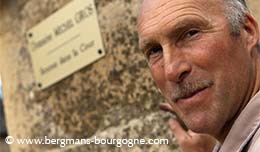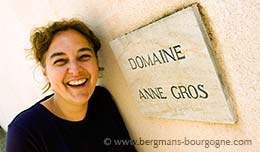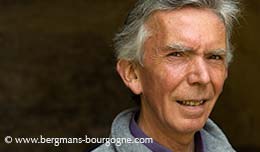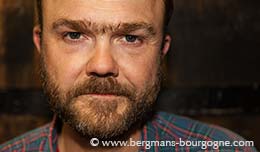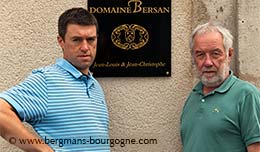
pineuil and Tonnerre. This used to be one of the major subregions of Burgundy. At the end of the 19th century the Tonnerrois vines covered more than 5000 hectares. Today only a fraction of that is planted.
– The soil is fairly homogeneous across the appellation. But we need to re-discover the best parts. That is why it is important to vinify all parcels separately. It is interesting work and I am sure we will find some very nice parcels this way, says Dominique Gruhier in Épineuil.
 Since 1989 he has been busy building his domaine here in the northwestern corner of Burgundy, half an hour northeast of Chablis. Originally it said Domaine de l’Abbaye du Petit Quincy on the labels. Now it is Domaine Dominique Gruhier. Today he has a total of 28 hectares, producing mainly Bourgogne Épineuil and Bourgogne Tonnerre, but also Crémant de Bourgogne and some Chablis.
Since 1989 he has been busy building his domaine here in the northwestern corner of Burgundy, half an hour northeast of Chablis. Originally it said Domaine de l’Abbaye du Petit Quincy on the labels. Now it is Domaine Dominique Gruhier. Today he has a total of 28 hectares, producing mainly Bourgogne Épineuil and Bourgogne Tonnerre, but also Crémant de Bourgogne and some Chablis.
– In 1989 there was a grower who had planted vines here in Épineuil for his son, says Dominique Gruhier. This grower came from Orange, close to Châteauneuf-du-Pape and obviously his son found the climate up here a bit tough, so he was not very enthusiastic about the project. In the end his father decided to sell the vineyards. That was how I got my first four and a half hectares.
 The following year yet another grower decided to call it a day in Épineuil. It that case it was a grower in Champagne who had hoped the Champagne appellation would eventually be extended all the way to the Tonnerrois.
The following year yet another grower decided to call it a day in Épineuil. It that case it was a grower in Champagne who had hoped the Champagne appellation would eventually be extended all the way to the Tonnerrois.
– Obviously that didn’t work out, smiles Dominique Gruhier. I bought his vineyards, but they were in a pretty bad shape, so they required a lot of work. At about the same time this house came up for sale. It was in bad state as well. No windows and trees growing everywhere.
 Those first years were tough. Dominique Gruhier had initially planned to become an engineer, but during his studies in Dijon a cousin of his who was studying oenology dragged him along to wine tastings. Because of this he began thinking along the lines of combining engineering and wine, something on the technical side of the business, but eventually he ended up becoming a grower himself.
Those first years were tough. Dominique Gruhier had initially planned to become an engineer, but during his studies in Dijon a cousin of his who was studying oenology dragged him along to wine tastings. Because of this he began thinking along the lines of combining engineering and wine, something on the technical side of the business, but eventually he ended up becoming a grower himself.
But without a family domaine to take on everything had to be built from scratch. When he started out he had no cellar and no clients. 1991 brought spring frost and he ended up with yields at 18 hl/ha.
 – I started out with nothing, and it went backwards from there, he sighs. Then in 1992 wine prices hit a low with about one euro per litre. So the beginning was far from easy.
– I started out with nothing, and it went backwards from there, he sighs. Then in 1992 wine prices hit a low with about one euro per litre. So the beginning was far from easy.
In 2003 he decided to go organic. He began reevaluating the work at the domaine and began focusing more on quality. By 2009 the whole domaine was organic.
– Today we see the light at the end of the tunnel. It has been an adventure and it has been very exiting.
Just northeast of the domaine in Épineuil is Côte de Grisey, often considered as the best part of the appellation. When you visit the place it becomes apparent that there remains a lot to be planted. Together the vineyards of the two appellations of Bourgogne Épineuil and Bourgogne Tonnerre only cover about 250 hectares.
 – There are still not enough growers within the appellation, says Dominique Gruhier. We are about 50 in the whole Tonnerrois. 20 to 25 of them can be found in Épineuil, but only ten are full-time, or close to full-time, winegrowers. Some just sell the grapes for Crémant de Bourgogne. There is less Bourgogne Épineuil bottled today than there was just some years ago. 250 hectares remain to be planted. Not everything is great, but at least 100 hectares are very good.
– There are still not enough growers within the appellation, says Dominique Gruhier. We are about 50 in the whole Tonnerrois. 20 to 25 of them can be found in Épineuil, but only ten are full-time, or close to full-time, winegrowers. Some just sell the grapes for Crémant de Bourgogne. There is less Bourgogne Épineuil bottled today than there was just some years ago. 250 hectares remain to be planted. Not everything is great, but at least 100 hectares are very good.
Bourgogne Épineuil is limited to the commune of Épineuil, whereas Bourgogne Tonnerre may be produced in Dannemoine, Épineuil, Junay, Molosmes, Tonnerre and Vézinnes. Bourgogne Épineuil is red or rosé, made from pinot noir or pinot gris. Bourgogne Tonnerre is white, made from chardonnay.
 – Chardonnay is easy to grow here in this part of Burgundy, says Dominique Gruhier. For the pinot noir the terroir is much more complicated. It requires a lot of work. You can’t vinify it in the same way as in the Côte d’Or. Because of the minerality you have in Épineuil you have to tread very lightly. You can’t extract the tannins because they don’t go well with the minerality. If you do you get a very heavy and austere wine, sauvage.
– Chardonnay is easy to grow here in this part of Burgundy, says Dominique Gruhier. For the pinot noir the terroir is much more complicated. It requires a lot of work. You can’t vinify it in the same way as in the Côte d’Or. Because of the minerality you have in Épineuil you have to tread very lightly. You can’t extract the tannins because they don’t go well with the minerality. If you do you get a very heavy and austere wine, sauvage.
Dominique Gruhier produces four red Bourgogne Épineuil cuvées. The standard cuvée is a blend of several parcels from all across the appellation. 50 per cent is harvested by machine – this part is shrinking for each year – and 90 per cent is de-stemmed, producing a fruit-driven easy-drinking wine.
 One step up is the Bourgogne Épineuil, Côte de Grisey. As the name suggest this comes only from the steep slope of Côte de Grisey with its Kimmeridgian soil. The exposure is south or southeast. 30 to 40 per cent are whole bunches, with some extra stems added.
One step up is the Bourgogne Épineuil, Côte de Grisey. As the name suggest this comes only from the steep slope of Côte de Grisey with its Kimmeridgian soil. The exposure is south or southeast. 30 to 40 per cent are whole bunches, with some extra stems added.
– Then I have two cuvées where yields are lower – Cuvée Juliette and Cuvée L’Ame des Dannots. Cuvée Juliette are my best parcels from Côte de Grisey. It is 100 per cent whole bunches. Cuvée L’Ame des Dannots comes from a parcel called Les Dannots. It is facing southeast and it is not particularly steep. The soil is deep. Cuvée L’Ame des Dannots is a bigger, more powerful wine than Cuvée Juliette.
The standard cuvée of Bourgogne Épineuil sees no new oak. The Côte de Grisey sees between 15 and 20 per cent and the remains two cuvées about 30 per cent.
© 2017 Ola Bergman










